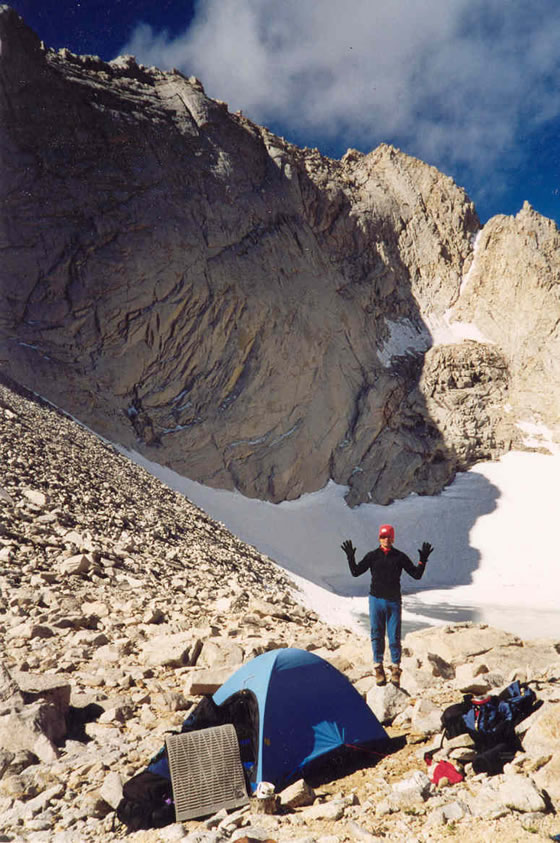
Comments about the limits of UL packs - taken from 'Letter from Dan' blog - The comments below may seem disjointed because they been pulled out of my blog letter and stacked here. The newest are on top. There may be a little redundancy! I have been involved in critiquing frameless packs since the 1970s. McHale Packs regularly makes high-performance packs between 2.25 lbs. and 3.5 lbs. The performance ratings of packs in this weight range can be very subjective and really very meaningless. Some people think there are lighter weight packs on the market which are perfectly comfortable for lighter loads, maybe to 20-25lbs, but that's all about de-emphasizing how much 20-25lbs does to a person after a day of walking.
The word 'maybe' in the statement above can cover much territory and discomfort. The other word to look at is 'perfectly'. What is 'comfortable' varies widely in the UL community. Since my company is relatively unknown compared to the big players, you can be sure that most people that come to us, and end up liking the packs, have tried the others first. Most of my business in all pack categories is from people that have tried other packs first. Many people make the mistake of thinking 20-25 lbs is not enough weight to really consider the 'performance' of a pack. These are the people that end up purchasing one cheap pack after another.
Below; Camping below the North Face of Mt. Russel in the Sierra Fall late 90s. On that trip I was carrying a 'relatively' light load in a Critical Mass pack to see how adaptable the larger packs were to lighter loads like 35 lbs. Based on the arguments gathered below it makes sense to carry light loads in larger packs. I certainly have never had a problem with it! The empty pack on this trip weighed about 6 lbs. The trip started at Whitney Portal and went over the Russell/Carillon Col to the Kern River Mesa. We wanted to go around and climb the back side of Mt. Whitney but were snowed out and retreated out over Shepard Pass.

If you are somebody that's bouncing back from low performance over-hyped UL packs, you came to the right place. It's a big lie that many of those packs, that have an upper advertised limit of 25 or 30 lbs, can even carry those weights well. ( I talk about this and other subjestc quite a bit in many sections of this letter lower down ). Comfort is a very subjective term. The standard seems to be, that if a pack does not kill you, it is labeled comfortable. The UL pack industry operates at a pretty low standard of performance. The performance of todays frameless light packs is no better than the frameless packs from the 70s, when part of my business then was to install frame systems into frameless packs for people that asked for help. The UL part of the current industry has indeed found a way to take us all back in time! I do not get tired of ranting about it though. I have had countless conversations with people that have come to agree. Way down in this letter I talk more about the importance of a good pack and how it's not ALL about what the packs weigh. To focus on weight alone is 'dumb engineering' and leads to poor results to say the least. If you are suffering with a bad daypack, do your self a favor with a high performance daypack like our smaller LBPs - you deserve it, especially if you are a tall person.
A pack example for the argument below: A Popcan P&G made of our lightweight gray Dyneema Grid Fabric. Even though this pack is fairly large and full featured (4,000 cuin ),with an upper bear cannister circumference of 42" tapering to 36" at the bottom with Dyneema Kangaroo pocket, Lg Crest belt pouch, Presto shoulder pad, P&G extension Bayonets, it weighs 3 lbs, 15 oz. Then, stripped down to it's smaller roll-top mode it is 2 lbs, 14 oz. Switch to a webbing hip belt and it's 2 lbs, 10 oz.
Going much lighter than this, though, heads into the direction of diminishing returns, and becomes a game of numbers rather than subjective performance. There are already plenty of packs on the market to play base-weight numbers with that sacrifice performance. Even a load as light as 20 lbs becomes a burden in a pack that's too light or just does not work or perform. Many of our customers have been there and done that. What's the point in going light if it does not feel good? 20 lbs is still like carrying 4 five lb bags of sugar - a lot of weight to just hang on the shoulders - there's really nothing light about it in a bad pack. Twenty pounds sounds light, and should feel good, but a bad pack actually amplifies the effect of the weight. Many of the packs rated at 30 lbs, don't even feel good at 20. The pack below carries 30 lbs like it is not even there, but it does not get you into a UL light pack contest. Sure, it's OK to put 16 oz backpack on the spreadsheet, but the reality is, a heavier pack that works makes a huge difference at the end of the day and does not wear you down because of the extra ounces. The UL community claims the extra ounces will wear you down. If they don't claim that and the extra ounces don't wear youd down, why carry an uncomfortable pack?! It's the light pack that wears you down, not the more effective 'HEAVY' one.
It is impossible to stuff a frameless pack with a 25-30 lb. load and make it remotely as comfortable as one of these custom fitted framed packs, or most other internal-frame packs. Even then, the framed pack in these weight ranges does not have to be stuffed in any particular way to still be more comfortable than the frameless pack. The frameless pack has to be stuffed very carefully and even then it fails. Frameless packs depend on their contents for some kind of support, so whenever something is taken out, like clothing, they lose support and fail.
Why is there so much emphasis on pack weights in the marketplace? It's simply much easier to show what a pack weighs rather than what it can do, as if what it weighs means something! The awful reality is that it is very difficult to go light enough to make frameless packs comfortable at all. Even at the weights they are designed for, they are awful. We are not a country full of mechanical engineers, (even though it sometimes appears that way) so many people don't understand until they suffer needlessly and need help. If all a pack can do is be light, it's not really a pack. A pack that weighs between 2 and 3 pounds is very light, especially when it can super comfortably carry even 35 pounds, but in the UL community it is looked down on. There was a significant frameless-pack revolution in the 70s that failed. It was more FAD than revolution, however, much like the current fad/farce. The internet is such a shill-zone that it is difficult to see that the current fad of frameless packs is failing as well. From experience I know most people don't go to the mountains for torture and I mostly write this to lend support to people that want to hear what's really happening. There is a reason I refused to make frameless packs in the 70s - it's the same reason I don't make them now. Many people try frameless packs because the buz on the net sounds so great, then they realize it was just a waste of money. Much of my business in the 70s in my Boise Idaho shop was devoted to putting frames into the softpack frameless brands like Rivendell, Chouinard UltimaThule, Yakpak, Wild-X ROR, Dana Klettersacs........Boise at the time was a fairly quite little town, yet even there the amount of dissatisfaction with these packs was significant. Multiply that by all the activity country-wide. The same thing is going on now. Below, me with medium weight binoculars.
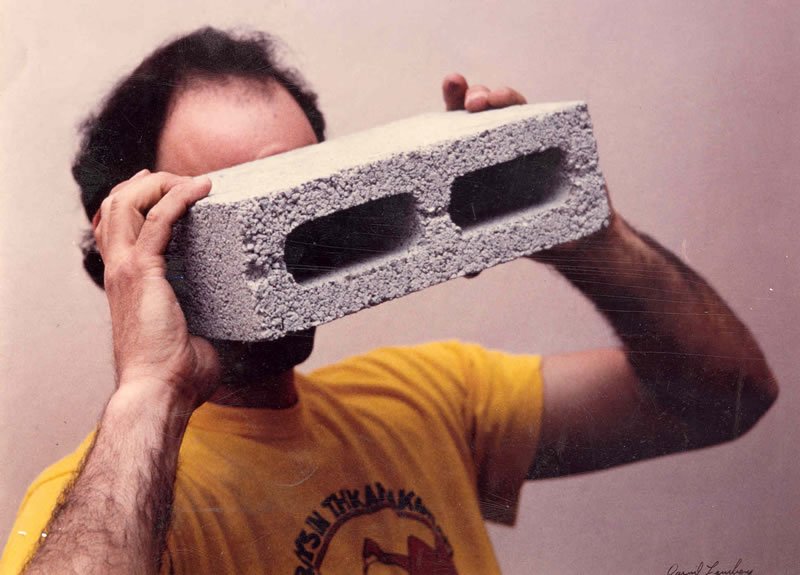
I keep using my letter here as a preview page. Sorry! There's lots of stuff down farther if you start scrolling....... There is even quite a bit about being sensible when it comes to downsizing to UL packs - how even a 25 to 30 lb load can be very uncomfortable in a pack that is too light and does not have enough structure. You knew that! Thinking back to the Bucky Fuller days and building Tensegrity models, that is the sense I have for the packs. Tensegrity was short for Tension-Integrity. To me that means 'Make it Float'. The components all have to pull together and do their jobs. What makes it even more complicated though is that is usually helps if it fits, and then the owner has to know how to use it!
There is now plenty of lightweight gear on the market to significantly lighten pack loads. It makes no sense whatsoever to completely destroy the tool that has to carry what all of the lightweight gear still adds up to though. I could make packs that are lighter than what I make, but I do not want to make gear that does not perform well, and I will not be caught telling people something is comfortable or should be, when that is a physical impossibility. With such light loads, what is the point? The empty pack weights and limits of what is acceptable in the UL community are as arbitrary as anything can be. Performance is something much more difficult to put a number on than just dumb weight, and people even fib about that. As it stands, much of my business is from people that have already explored the line where packs are so light that they no longer work AND make things rather uncomfortable even though the basic load is pretty light. I have explored it plenty for more than 30 years! When loads go under 30 lbs, as an example, it makes absolutely no sense to try to get things to 25 lbs rather than say 27 lbs, if it means hiking all day with a pack that truly sucks your energy.....but you knew that too! The myth of the SUL backpack that makes light loads feel lighter, and lets you walk farther, is alive and well. The hardcore competition to publish lighter base weights on the net does not take into consideration overall well-being.
Letter below: The long last half of this page (you have to scroll way way down - farther than the latte cup in the water bottle pocket I think) is about packs that are too light to work well - a compilation of thoughts from the last few years - mostly about thinking more rationally about what is a good practical empty pack weight. Go light but carry it in a good pack is what I like to say. Going light is good - that is backpacking - always was for many people. You will enjoy walking immensely more with a pack that performs well rather than with a pack that is just light - or, rather, too light. All packs work to some degree - some just work much better than others!
The cost of a thing is not about what you spend on it, but how much it does or does not reward you in ten years. Some packs cost you by not rewarding you and many packs pay back in spades. Unless people have tried many different packs, they do not understand how different they can be from each other. Like a custom Bicycle builder, I participate in the construction and assembly of each and every pack. To me sewing is a form of machining that I have my own high standards of to insure ultimate reliability. I see a backpack as a machine as well. Having my own standards for the performance of the machine is what sets the packs apart. There are many backpackers and climbers that go out in misery year after year after year and do absolutely nothing about it and THEN over-react and buy something too light and/or too small, and no matter how IT is loaded, IT does not work, and they are still in misery. The pack industry today is in turmoil and confusing to many. I believe in going light, but do not think going light has to mean you do it with an annoying uncomfortable pack.
Lightweight thru-hiking and backpacking: There are lots of people that have much invested in making people think that the urge to go lighter is something new and that people did not do that in the 'old days'. Read my Muir Trail thru-hike story in the secondary menu at the top of this letter and see what you think. I was 17 or so, and just imagine, without today's UL websites, or gurus that think they are reinventing backpacking, I managed to load up a pack and walk from Yosemite to Mineral King in 11 days starting with a total load of just 40 lbs - yes, we weighed our packs back then too. The best part is that I used a real pack to do it too, a simple external frame, that in principle was far better than the frameless bags many are using today. Even today people would have a hard time doing what I did over 35 years ago. That's proof it's not about minimizing the pack but minimizing the load. If I could go back in time I could use the same Camp Trails external and break any existing Muir Trail record, I just wouldn't have time to fish this time - at a certain point the backpacking turns into something else and it's not backpacking at all any longer.
Backpacking is evolving that's all, like so many things do. Some things are better and some aren't. Lighter does not always spell 'Better', especially in the case of packs. Lighter can spell STUPID. With all the talk these days about developing core strength and core energy - most of the packs being promoted for light packing are antithetical. A pack needs to have it's own effecient skeletal structure to preserve both the core of the pack and the carrier. Frameless or 'structureless' packs beat people down much more than is realized.
Mountaineering especially is not the place to skimp on packs - learning the hard way is what's all about though - Ya Sure. Ya Bet Ya! There are many people that need to carry 30 lbs. and more that are fooling themselves and being fooled by what is going on. It all comes down to just how much the load can be 'enjoyed' and whether that is important to you. There are many people out there that can't wait to tell you how 'comfortable' their uncomfortable pack is and how great their gear spreadsheet looks. Truth is, you can tell when somebody is uncomfortable just from watching their body language, they don't have to say a thing! People do not understand the psychological toll uncomfortable nagging packs take either. Just start looking and paying attention. All those packs hanging back from peoples shoulders actually suck their energy far more than a little extra weight.
Let's talk about the .73% difference in weight that is attained if you weigh 175 lbs and carry a 32 lb. load in a 3 lb. pack and go to a possibly very uncomfortable 1.5 lb. pack. That's right - big suffering to save .73% off the total of this mass hitting each ankle with each step. That's the logic many have become involved in. When are people going to start talking about percentage increase in discomfort that comes with sacrificing the pack performance just for the sake of numbers? Getting too caught up in making things lighter does not always lead to positive results. Being miserable every day of a backpacking trip to save .73% is not what it should be all about - especially if you don't need the .73% ! I also talk about why the backpack should not be considered one of the 'big 3'.
Why isn't there a 'big 4'? Hell, boots can weigh a lot, especially if you have big feet. The Peter Boot Principle can have more dire consequences than the Peter Pack Principle. I'm supposed to feel stupid hiking in my 4lb.,7oz/pair size 14 Zamberlans. These can easily weigh more than any of my big 3. To put my boot weight into perspective though, my average running shoes weigh 2.4 lbs/pair. I have spent plenty of time hiking and backpacking in running shoes. If you do a good job of lightening your load you won't need to skimp on the important items......much depends on just how good your feet still are! Personally, I have some old climbing fall, skiing fall, snowboard fall sprains I have to watch out for. The days of backpacking in running shoes for me are no longer! Below, Granite climber sculpture at Squamish Chief, Canada.

Welcome to GoLightButCarryAGoodPack.Com
I say more about the above 'mini-topic' lower down in the letter about light packs Vs. lighter packs. " GoLightButCarryAGoodPack " really says it all. There are always people clamoring ( definition: a loud sustained noise ) to take things to the limit of what no longer works well. That's not the business I'm in. As far as packs are concerned, the industry in general seems to be stopping at a certain place with the weight of packs and is leaving the rest to the fringe. The fringe? Don't get me wrong - I respect all forms of packing - I just happen to be fascinated with packs that work at a high performance level like anyone that would be fascinated by a good tool. I would simply like more people to be smart about it. It seems like I go over and over it in this letter but that's because I go over and over it all of the time! I really get pissed off by these people that preach going so light with packs that you'd swear the 20 lb. on your back is 50. Then when they try to do an unsupported long trip manage to make 50 lbs feel like 100 in some pack that is still not worthy. To be part of the UL club it is important to be uncomfortable at whatever level you participate. The pushers don't mean harm but they do harm. Lot's of these people don't quit or shut up until they've got you into a truly uncomfortable pack - one that you dare not carry anything in. A soft and simple ignorance is trying to rule the roost. History repeats itself because after awhile history simply becomes lost in the shuffle. God, if we can't keep pack history straight, imagine what REAL history is all about. Knowledge is supposed to build on top of knowledge. The knowlege actually seems to be avalanching on itself and then scrambling to rebuild, and the loudest voices win out.
In the 1980s and 90s I applied the well known Peter Principle to backpacks. The Peter Principle states that people will rise in an organization until they reach a level where they can no longer be fully competent at what they do. The contemporary version of the Peter 'Pack' Principle states that people will acquire lighter and lighter packs until they reach that point where the packs no longer function well. Some people are smart though, and bounce back over the line and prefer comfort over bragging about their 'base weights'. The current frameless pack craze is not new. There was one in the 70s and 80s. I made part of my living in the 70s rebuilding the many famous frameless pack brands people would bring to my repair shop, begging me to put frames into them. The local shops in Boise where I was located would send people to me because they could not help them. That was my introduction to 'soft packs'. It was the era of the Ultima-Thule pack. It says a lot about this era that Chouinard starting advocating the use of Tump Lines. I'm not sure it's sad or funny to see the same thing happening all over again.
There will always be people building packs that do not work, and always someone to make a pack that does not work that is even lighter, and there will always be people that say how great the packs are. There are still people saying how great the soft packs from the 70s are/were. They were awesome as long as they were empty. The internet is wonderful. You can find people that say good things about whatever item you want."
'''''''''''''''''''''''''''''''''''''''''''''''''''''''''''''''''''''''''''''''''''''''''''''''''''''''''''''''''''''''''''''''''''''''''''''''''''''''''''''''''''''''''''''''''''''''''''''''''''''''''''''''''''''''''''''''''''
Just sitting around!
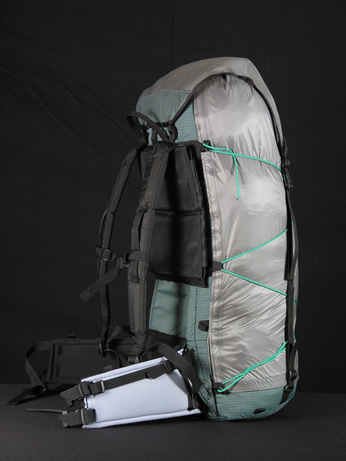
Above: A light fully padded internal frame pack I made that's just sitting around not getting used! It's one third dyneema grid and 2/3 silcoat. Why aren't these on the site? Mostly because I believe packs should only be so light ( for security and safety reasons ) and do not feel right telling people they should be lighter than I think they should be, regardless of what the rest of the world is doing. We're talking 3 lbs in most cases and even 2.5 lbs at 4500 cubes. If made simply enough even a framed Dyneema Grid pack can easily weigh 2.2 lbs ( Subpop style ). To go lighter than that with the pack just does not fly around here - I just can't get my head wrapped around throw away packs. It's also because much of my business is working with people that do extreme things - the pack is one of the barriers between you and the extreme. Because there is some trade in used McHale Packs I also like to feel that anyone buying a used McHale Pack will be buying a safe pack that will be reliable.
Going light is about what you take and carry in a pack and as such, the pack is NOT one of the 'Big 3' but one of the most important pieces of gear you can buy, at least as far as comfort is concerned. A pack is something that is on the back for many hours a day and is not a passive piece of gear like a sleeping bag or tent. Everything in the pack may be 'ultralight' but adds up to loads that never seem to be ultralight! Irrational exuberance is something we all suffer from at one time or another. Beware of putting too much emphasis on empty pack weight - it is not a practical religion - going with a lighter load is. It seems to me that a sub-3 lb. pack that is failsafe and can carry a significant load is better than a sub-2 lb pack that might not get you home and feels like hell even if it does. The silcoat pack above does not break 2 lbs anyway ( because of it's size and some special features ) . This year may be one of the peak years that we see people out on the trail with relatively light loads that are still suffering because their pack is too light and inadequate because somebody convinced them that internal stays and padded belts and good design are excessive. Don't get me wrong though. I have absolutely nothing against people doing what they want and experimenting. I simply want to make clear what it is I do here and where I draw the line.
I have been building light packs for quite awhile. Way before there was a Ray Jardine people were packing with my 1.5 lb. 3,000 cuin. internal frame summit pack. We built quite a few of these in the eighties and ninties. People bring them in regularly to have the bottoms replaced and get holes patched. The pack did not have padded shoulder straps or a padded belt. I did draw the line at having padded stays! Today it is easy to talk reasonable people into more comfort and slightly more weight for their pack. There are plenty of throw away packs out there - I don't need to make more.
Been There Done That!
You've come to the right place if you are hovering between the ultralight world and the world of reasonably light. I'm a bit old fashioned and know that going light means not taking a bunch of stuff you don't need - this is more important that getting a light pack that is TOO light. I know there are many people suffering needlessly even though they are carrying relatively light loads! My personal style revolves around 2 major items; a good pack and a light but very adequate tent (when needed) to pitch once I'm done for the day. Of course, having enough clothing is important.....then there's food.....Keep your load light so you can get to where you are going and then be secure when you get there! Below: Me at Thumb Rock, Liberty Ridge. I carried a non-bayonet S-Sarc. That vintage parka I'm wearing is Snowlion Polarguard!
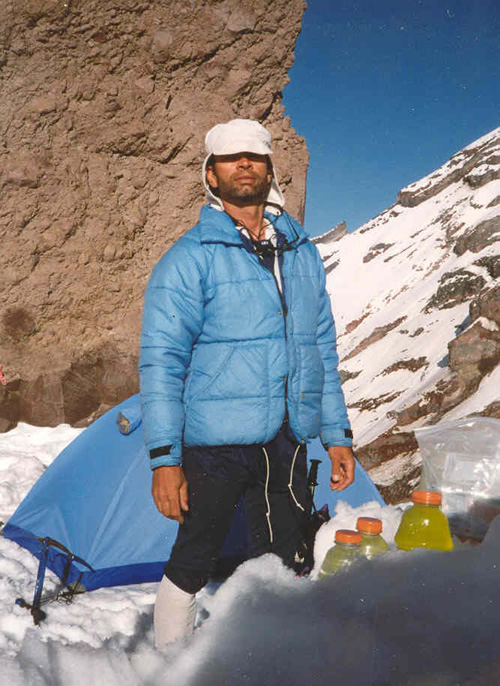
Above: Me at Thumb Rock on Liberty Ridge. Below: On top of Mt. Rainier in the early 90s - 2 days of storms on top after climbing Liberty Ridge! I led our group of 4 trying to find the way to the Wintrop Glacier from the summit of Liberty Cap in a white-out but kept walking in circles and falling in small crevasses. We finally camped behind the only rock up there and were lucky to find it, just above the Russel Ice Cliff! We ran out of food, fuel, and water, but we were secure - almost! I had a killer crome/molly steel shovel but could only dig a cave big enough for one person lying down, I dug that in case the tent blew away which did not happen - but almost! Nothing irritates me more than the way some UL websites have to claim that 'Traditional' backpacking and climbing was somehow done with double and triple weight loads, and that the styles being used today are far lighter. What a bunch of crap. Sure there are probably many unseasoned people out there that need the experience to gradually learn what they need and don't need to survive, but there is no way the loads would be any lighter today than what I carried back in 1993. Oh sure, I could obsess over the weight of my pack. Even back then I could have carried a full spectra pack up the ridge, but I knew better - most of what it takes to do these climbs is not what you learn from a UL website. I could easily have done the climb in a day and so could one of the other people along on the trip. We could have done that without changing any of out gear. The two others however, would have done no better no matter how light their loads were. We could even have carried their loads for them and we would not have gone faster! And then, having less than adequate gear for what happened on the summit could have been disasterous.
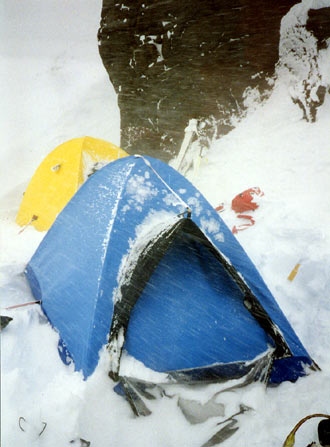
I know the toughest part of packing is just finding the time to do it. There has always been light gear and it has never been a secret that if you don't have to carry a 40, 50, or 60 lb. load you don't. If you have to carry 60 lbs there is no way to make it lighter than 60 lbs! You knew that! As a packmaker I like the challenge of making packs out of good old fashioned fabrics (that are actually quite remarkable) like 420 high tenacity - HT - pack cloth - USA made ( there are many imitations that have the tear strength of cotton! ) and making them reasonably light - after all, it's what you put in the pack that will make or break you. If a company says they use 420 denier fabric it does not mean it is a high quality version.
Anyway, you can get what you want here and I won't argue with you whether you want a 2 lb pack or a 5 lb. pack. To my way of thinking; if you put a 30 lb load in each the percentage difference is just not that significant - especially when you consider the comfort advantage. It is even less significant when you throw your body weight into the mix, which is what most formulas leave out. Yes, being overweight in the body has it's own impact, not the least of which is the negative effect it has on pack performance - hipbelt effectiveness etc. You cannot wear a hip belt high on the hips around the illiac crest or 'crest' over it if you are overweight - the bigger your belly the less you should expect from ANY brand of pack. A large belly forces the hipbelt too low and then interfere with leg stride and blood flow. It's the impact of your total body and pack weight taking each step and that 3 lbs difference in pack weights out of 200+ lbs isn't going to change things. Let's say you weigh 175 lbs with your boots and all, and your total load including your 3 lb pack weighs 32 lbs. That's 207 lbs landing on each step! Getting a 1.5 lb pack at this point will make a .73% difference - woopie! Anyway, this is just the tip of the argument iceberg. I know it sounds stupid but I like to say you are better off carrying a 30 lb. load in a 10 lb pack that works than in a 1.5 lb. pack that doesn't. This makes even more sense of course when you look at what even a 3, 4 or 5 lb pack can do. There is a lot of cult pressure to use 1.5 pound packs. There is such a thing as cult stupidity. Learn to tell by just looking at people to see if they are uncomfortable. They have always been out there and they are there with 1.5 lb. packs too. The notion that you can't be uncomfortable with a 1.5 lb. pack is just more cult stupidity. I get a kick out of looking at photos of packs on people on the internet. It is easy to see when a pack is uncomfortable without even being there - but it's all relative.
You might have to carry a 4 or 5 lb. pack and it's not as bad as some make it out to be. A 4 lb. pack is light, even if I have to say so myself. I had a 4 lb. pack on this Rainier climb. A lighter pack would have made no difference whatsoever in the outcome. Even if we went lighter, at least 2 of the people with me could not have kept up even if I went faster. The best argument for a five pound pack is the 15 lb load. So you have to carry 20 lbs when you have a 5 lb. pack instead of 16, 17, or 18. It starts to get pretty silly and you start wondering what it's all about. What!? I'll take the pack that gives me the option to carry the rocks that are in my head in the pack. People from just the last generation would think we are all a little touched I think. The more generations you go back the more..... On the other hand, I do understand the urge to roll up in a tyvek tarp - and I understand that can get old! Going light is good. It's much easier. Personally I prefer a light enclosed tent to keep the bugs, snakes and even larger critters off of me. I was born and raised in Southern California. It only takes one encounter with a cougar sneaking into your camp at night to make you think twice about a little more barrier. It happened to me when I was 17 or so in the Los Padres National Forest on Piru Creek in Piru Canyon - that would have been 1969. I woke up at about 2:00 in the morning with a cougar within 10 feet - just the other side of our packs! I was with my Stepfather and little brother. I have to admit the circumstances were unusual; I was practicing survival techniques and sleeping without a sleeping bag on top of a warm firepit covered with sand. I'll bet I smelled pretty good to that Mtn Lion! I actually had a .38 revolver with me but by the time I had it in my hand the cat was gone. The interesting part was that the cat did not panick and run in fear - probably because I didn't! Instead it ambled off in kind of a casual/stealthful way. I must have been a cool cat myself! Mt Cobblestone was my first love affair with a mountain. I was all over that place and the ticks were usually all over me!
There is a huge psychological aspect to backpacking not to mention situations like this! If you don't enjoy what you are carrying who cares about the rest of it - believe it - a 25 lb. load can get to feel pretty lousy if it's done wrong. It can feel much better in a slightly larger pack, for instance, spread out and not stuffed like a rock in a pack that is really to small AND too short. . A slightly larger pack can move and flex with you instead of being an annoying lump in your back. Getting a pack that is too small in volume and/or fit makes about as much sense as getting boots that are too small or not adequate in order to save weight or to look sleek ( I know - I have size 14! ). Already, many of the companies that started off making frameless packs in this little revolution going on, are making packs with frames as I predicted they would. They all think they are doing something new - making new ground - but they're just newbies. I could make packs that don't work but I refuse to be stupid. It's simple; refuse to succumb to idiocy and trust what you think feels better. It is my personal knowledge that backpacking has taken quite a plunge backward in time at the very same time that it has gone forward with the advent of newer lighter gear.
Below I speak strongly because I understand the real world of backpacking. Backpacking is not the rosy picture of people gliding down the trail with perfectly performing and adjusted packs like you see and read about in 'the' magazines.
Typically, even the people that review all those sexy packs know much less than people automatically give them credit for. Who am I to say this? I say it because I know it to be true from a lifetime of experience and from experience with my own packs being reviewed.
I feel your pain. In fact, I cannot look at a photograph of a backpacker in a magazine without analyzing the fit of the pack in the photo. I even try to determine if people walking down the street are long, average, or short torsos! It's probably the same for bicycle builders and tailors. Come think of it - I just talked this morning (5/8) with one of my customers that just started building bikes again and just finished a tandem. I think if I was in the rear I would want a long torso! And that is just the beginning. This is not just about getting fitted properly but about pack designs that are different from the standard packs on the market. Carrying a pack is a very dynamic process that is not well understood. Unlike other sports like cycling where a relationship with a machine is paramount, the sport of backpacking in general, as it relates to packs, is still very backward and ignorant - yes, even in the ongoing Super-Revolution. Hey, it takes guts to say this! I base this firmly on what I get to see and hear every day. For those of you that know the importance of seat height in cycling, imagine if you were all riding around with your seats far too low and you didn't even know it. This is the state of many people carrying packs. They don't know how badly they have it or what they are missing, or they just want that stupid little pack to work so badly that they deny that it doesn't!
I know that packs are much more difficult to get performance from and operate and get fitted for than a bicycle - The repercussions are much more horrible too! This is why people spend thousands on a bike and borrow their neighbor's pack - backpacking can really suck so why invest in it..
Below: me boulder hoping in the Sierra ( Dana Plateau ) 6 seasons ago with a short torso. Can you tell ? Tioga Pass road is visible below my right foot.
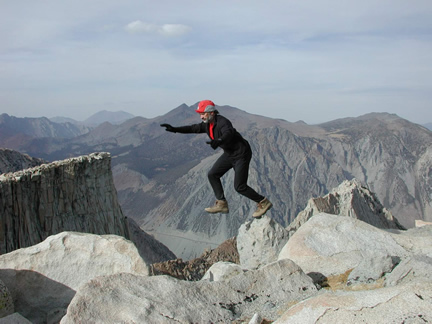
If anyone is confused about where I stand in the ultralight thing vs. whatever I can say that Backpackers are discovering what us Climbers have known for years - the value of going lighter - it is nothing new. Leave it to the business world to make the world seem new every year. Climbers have to go lighter because they have to carry that damn climbing gear also and do those huge elevation gains and loses - oh those knees!. The world is always trying to be lighter. That helmet alone weighs......! I always loved to go backpacking because it was so easy compared to climbing - not to mention the anxiety levels were a bit lower! For me, Backpacking was a vacation from the life and deathliness of climbing.